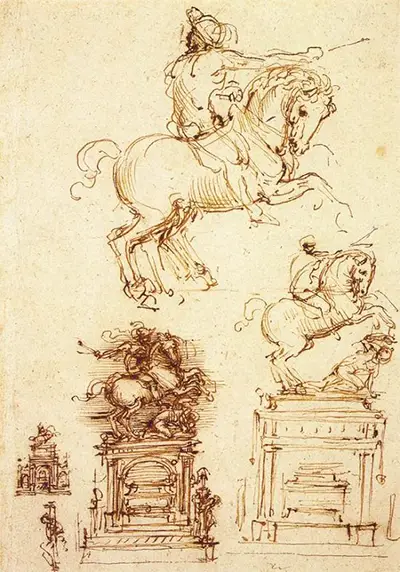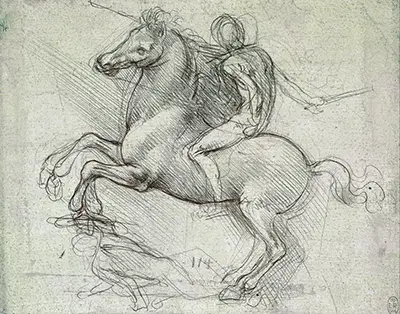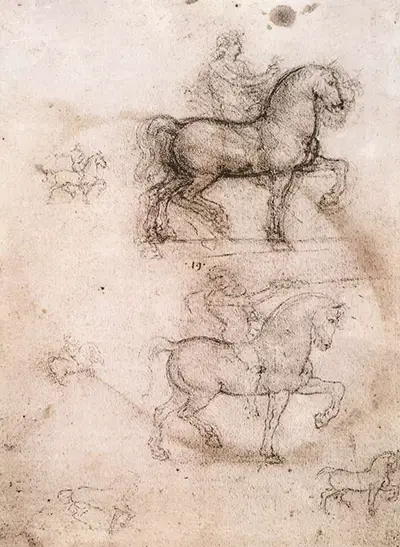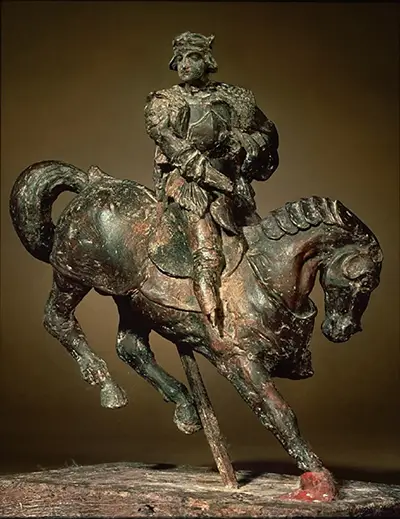Da Vinci's work within this field would advance his paintings and drawings, as well as vice versa.
The other Renaissance masters of Raphael and Michelangelo would also specialise more in some mediums than others.
Leonardo devoted much of his time to preparatory sketches for two specific sculptural artworks, namely his bronze equestrian statue for Francesco Sforza and also a monument for Marshal Trivulzio.
Neither of these two projects would ever be completed, due to a number of different reasons. The deep level of planning that Da Vinci would go into for these planned pieces is underlined by how he would even design the vehicles that would carry the completed works to their final display positions.
We are left contemplating what might have been with his work in this genre, causing most focus to remain in the present day on his paintings and drawings.
There is also continued discussion of what legacy may have been left had these sculptures been completed, but most art historians agree that they would be unlikely to have achieved the same academic respect as Michelangelo's Pieta and David, for example. Most feel this was not his strongest discipline.
With no completed sculptures to display, this section outlines the series of study sketches that he completed for the Sforza and Trivulzio monuments as well as describing how other, more recent artists, have taken inspiration from his career in order to produce their own sculptures.
Besides the monuments found here, Leonardo da Vinci would continue to use horses in much of his work. He found these animals enchanting and beautiful, perfectly suited to his style and qualities as an artist.
There is also a strong crossover between his work on the human anatomy and his studies of the horses found here.
Aside from his own contributions to this medium, many others have also taken on his work to create their own inspired pieces. A related sculptor from France worth studying is Auguste Rodin.
Sculpture inspired by Leonardo da Vinci's career
In the field of sculpture, Leonardo actually planned a number of sculptures before his demise. Sadly, he was unable to action many of them into final sculptures.
Some of those inspired by his own drawings and designs included Gran Cavallo (Horse in Bronze), Il Cavallo (the American Horse), Vitruvian Man Wall Sculpture and the Annunciation.
Though he didn’t do many monuments, a number of sculptures inspired by his paintings and life are available in the markets. They include Mona Lisa Bronze Sculpture, the Last Supper Sculpture, and Da Vinci Bust Sculpture.
Gran Cavallo
In 1842, Leonardo was requested by the Duke of Milan to make a horse sculpture. The artwork was to honour the Duke’s father, and it was to be placed in front of the castle. Da Vinci managed to sketch the biggest ever horse sculpture that was supposed to be coated with bronze later on. His sketch plan was appreciated by the Duke, and he couldn’t wait to see the real thing. During this time, France was a threat to Italy and bronze was used in building canons employed in protecting Milan. This halted the sculpture work as bronze was limited, and the artefact could not be completed. There was fear throughout Milan and Leonardo could not wait to concentrate and complete the work.
Considering that the French military was dominant over Milan, he fled the city and went back to his hometown of Florence for refuge and he never got back to Milan to complete the piece. It took many years before anyone considered to complete the work. Centuries later after his demise, the sketches made by Leonardo surfaced and presented an opportunity for someone to pick from where he had left. An American pilot became inspired by Leonardo’s work and founded a nonprofit firm named after Leonardo to complete the sculpture.
In 1999, the effort of this organisation paid off and the biggest horse sculpture was unveiled in Milan. It was 24 ft high and cast in bronze and it got everyone surprised and impressed at the same time. A month later, the second sculpture was uncovered in Michigan. These two marked the revival of Da Vinci’s famous Gran Cavallo sculpture. Today, there are many pieces in major galleries and online stores. It is available in different sizes and from different countries.
Il Cavallo Sculpture
In 1506, Da Vinci made a sketch of horse sculpture, similar to the one he did in 1842 for the Duke of Milan. The horse sculpture named Il Cavallo was dedicated to Giacomo Trivalzo. However, the artwork never got much attention at the time. In making this monument, Leonardo faced two major challenges. One, he needed to work on the belly space of the horse. Space on the belly was supposed to be filled. Secondly, Leonardo wanted to occupy the rider’s space. The rider was to be designed separately and placed on the horse.
Following his demise, a number of sculptors have taken the challenge to deliver a complete sculpture based on Leonardo’s sketch and design. There are a few variations in design but the original details are maintained. Today, a number of sculptures are available in the memory of Leonardo. The statute is normally procured to present an artistic appeal to homes and social halls. The display of the masterpiece promotes creativity and inspiration in a place. The image is of great beauty and amazement to the procurer.
For those who are Da Vinci fans and to those who just appreciate art, the sculpture is highly rated by them and they consider it as one of the greatest sculptural work. With many designs available in the market from different nationalities, more enhanced sculptures of the design are expected each day. The art industry is growing and sculptors are getting inspired especially by pioneers such as Da Vinci. For this reason, the Il Cavallo is an expression of better things to come.
Vitruvian Man Wall Sculpture
This sculpture is of historic importance. The wall sculpture is cast in high-quality resin and stone finishing. Initially, the Vitruvian Man was sketched by Leonardo as a painting and sculpture. Due to the fame that the sculpture sketch and painting gained over years, more statutes have been made of it. The pieces are available in different designs and sizes. The finishing also varies based on the preference of the artist. The available options include wood carving, bronze, and stone.
The display of the wall sculpture is significantly historical. The design is a representation of the great art mastery by the Italian Leonardo. Today, many art enthusiasts rate this sculpture as one of the best historic statutes inspired by him. It is a representation of style and essence in the art field. The display of this historic piece gives the room an appeal of beauty and class.
The existence of different designs and sizes make it convenient to be placed in any room. It can be put in museums and homes to display class and enhance beautiful room presence. The painting is appealing to all class of art enthusiasts. The Vitruvian continues to amaze and astound many art fans. The hype to deliver more enhanced wall sculpture is high and the market can only expect more of the Leonardo inspired Vitruvian Wall statute.
The Annunciation Sculpture
This piece of work has a similar appearance to the original painting but it’s slightly different in the finishing. It’s made of high-quality resin with a glossy finishing. Accompanying the package is a colour card that is written in 4 different languages. The artwork just looks amazing considering the historic and biblical significance behind the idea. It is a display of the biblical story about the birth Christ. The message was announced by Angel Gabriel to Mary about her becoming the mother of Christ.
Biblically, the annunciation of the birth of Christ is symbolic. It signifies the possibility of human salvation. Christians celebrate the birth of Christ during Christmas each year and so such sculpture adds relevance to the occasion. The messenger who in this case is angel Gabriel is clearly sculptured to appeal the message of hope to the believers. The annunciation was met by disbelief initially from Mary and this is clearly expressed in the statute. For Christians around the globe, the sculpture is very important as it highlights descriptively the contents of the Bible.
The sculpture is also historically significant as it outlines a piece that was carefully designed and crafted. The appeal gives an understanding to the art fan of the actual historical event. The artefact is a wonderful piece to put in a home or social setting. It is also displayed in museums and churches as a constant reminder of hope of humanity. For those who find it hard to read the Bible, they get to look at the sculpture as a constant reminder of hope. The Da Vinci Annunciation sculpture is of great essence to the current art world and the future ones.
Da Vinci Bust Statue
This sculpture is specifically designed in reference to Da Vinci’s mastery of the art of painting. He was referred to as the Renaissance Man. The sculpture has a bronze finishing and the artwork measures about 9 inches high. It has a Bulgarian origin. The piece is an upper body image of Leonardo Da Vinci. It is designed to honour Da Vinci. Historically, the Italian art legend has been instrumental in the art industry. His famous paintings are a motivation to many artists.
Having a statute image of him is an illustration of the achievement that this great artist managed. The statute is well designed and crafted to appeal the message intended. With Da Vinci’s name engraved at the bottom of the statute, the piece is worth a purchase. The bust statute is available in different carvings such as bronze, wood, and stone. The nature of material design dictates the market price and the cost may vary from store to store depending on the nature of material, design, and size of the piece. The powerful stand makes it suitable for any platform ranging from homes to art galleries.
The Last Supper Sculpture
This sculpture is a motivation from Da Vinci’s famous painting, The Last Supper. The piece is an artistic expression of the events recorded in the Bible that involves Jesus and his disciples taking the last meal. This was before Christ’s eventual death sentencing. During the last supper, Jesus happens to reveal to his disciples that one of them will betray him. The sculpture gives a detailed artistic feel of the actual event. The artistic appeal is more illustrative of the actual biblical event.
The piece is most convenient for churches and homes. Even those who are not Christians get to procure it because of its historic and biblical essence. The piece not only displays creativity by the artist but also inspiration considering the reference of the work. Da Vinci’s level of creativity is evident in this particular piece and one would just agape at the wonderful sculpture. The painting can be procured for many reasons but what is peculiar is the level of creativity in the piece. Most of the pieces are from Germany. The sculpture is found in bronze, wood, and clay carvings.
Mona Lisa Bronze Sculpture
This is also inspired by Da Vinci’s famous painting Mona Lisa. Most of the pieces are from the US. The painting was done around 1503 and 1519, and it acts as an artistic reference to sculptures today. The statute gives a detailed feel of the original painting. It displays a partial body of a woman (Mona Lisa). There is so much artistic touch interpreted on the statute. Her smile is an expression of Da Vinci’s cosmic idea of linking humanity and nature. The bronze sculpture is mounted on a firm solid base and it measures 12 inches in length.
According to researchers, the woman on the sculpture is believed to be Lisa Gherardini. Many art enthusiasts rate this sculpture highly and the reason is that of its historic importance. The appeal of the statute is also illustrative of the message intended by the Da Vinci. The statute gives an alternative artistic feel to the painting. A dominant artistic presence develops when the sculpture is around. The ambiance surrounding the figure is very inspirational from the artist’s point of view.





